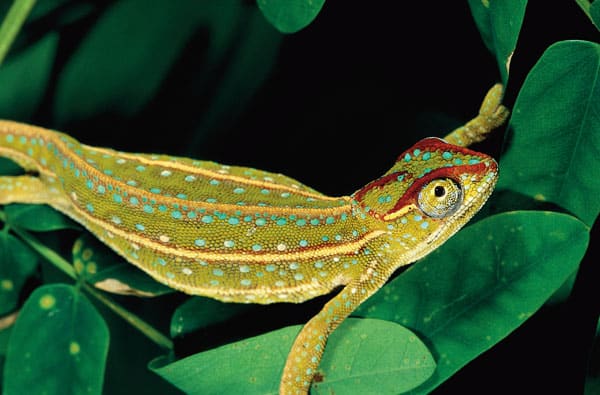Among the various environmental requirements you should know about any herp you keep is what relative humidity is normal in its native habitat and, th
Among the various environmental requirements you should know about any herp you keep is what relative humidity is normal in its native habitat and, therefore, what that should be in its vivarium. Humidity refers to the amount of moisture (water vapor) contained in an atmosphere. Humidity is measured in various ways, but the most common measurement used is relative humidity, which is expressed as a percentage (e.g., 55 percent) to show how dry or how moist the air is.
Read More
Designing And Building A Vivarium
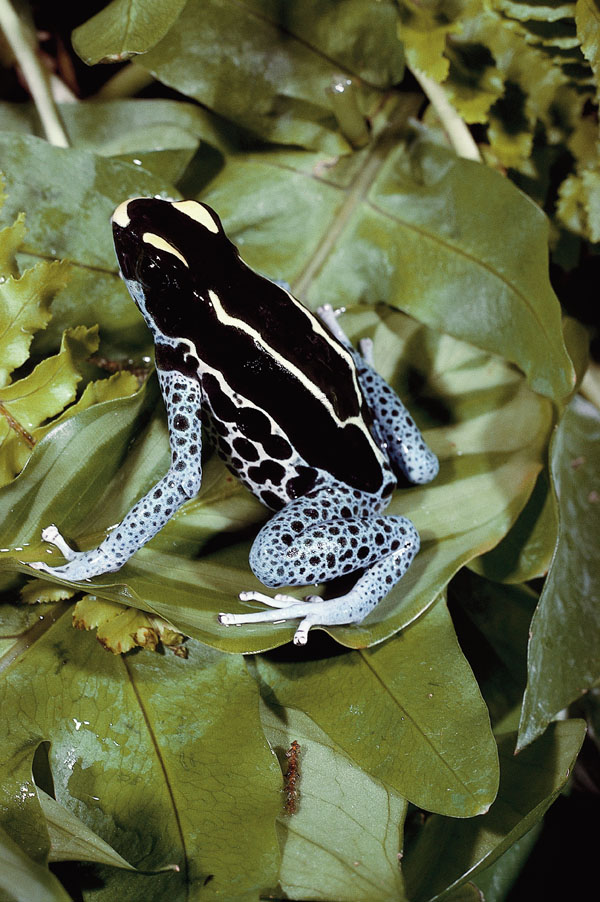
Rex Lee Searcey
To help maintain humidity and air quality in the vivarium use as many live plants as possible.
If you need to maintain high humidity in your vivarium, the easiest, most reliable way is to use a misting system. These systems range from simple setups to sophisticated and automated setups. Some you can purchase, install and turn on. Others you have to make. The system you choose depends on your do-it-yourself skills, how your vivarium is set up, your particular environmental needs and your budget. If you plan to make your own system, this article will help you with the project. If you plan to purchase a commercial system, this article will help you choose the right one. Whichever misting system you choose, there are several basic fundamentals to consider. Eight of the most important are discussed here.
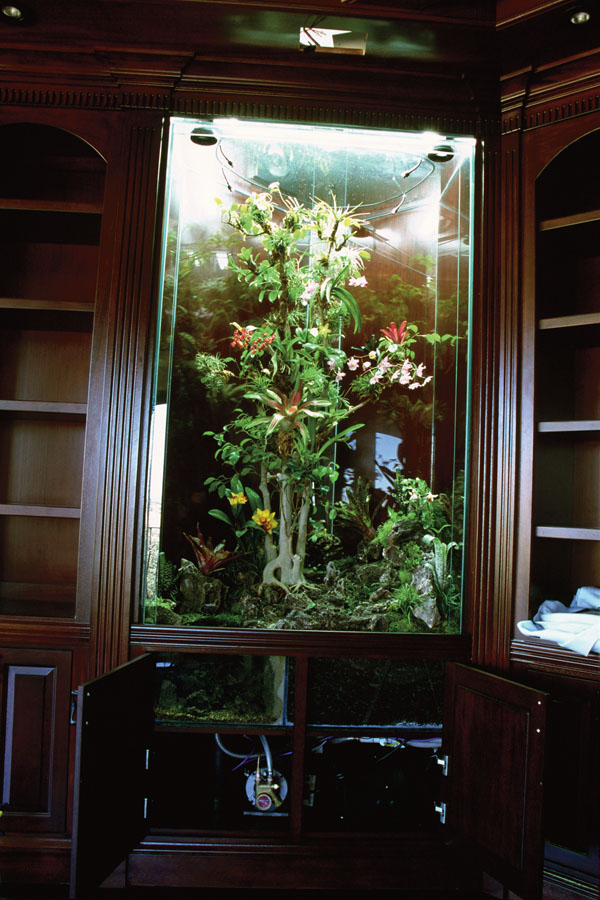
Rex Lee Searcey
Pictured is a misting system attached to a water source. Necessary components of any system include the water-storage container, pump, tubing and connectors, nozzles, timer, and hygrometer. Components such as a humidistat, a water-filtration system and an automatic water shut-off device might be optional depending on the situation.
(1)Purpose
Keep in mind that the purpose of a misting system is to maintain vivarium humidity — not to water the enclosure. Excessive water in vivarium substrates is a big problem, and it is responsible for the poor health and even death of many vivarium animals and plants. Once initially moistened, the vivarium substrate tends to hold onto that water, especially if the humidity is high. So actual watering is rarely necessary, and it should be done carefully and conservatively. You want a misting system that uses as little water as possible and provides as fine a mist or fog as possible.
(2)Operating Pressure For Reptile Misting Systems Vary
Misting systems can be generally divided into low-pressure or high-pressure systems. Low pressure is technically less than 100 pounds per square inch, but most low-pressure systems operate with less than 40 or 50 psi. High pressure is technically more than 100 psi, but the most efficient systems operate with more than 250 psi. In general, the higher the pressure of a misting system, the better it is at creating a fog or fine mist to provide the high humidity you want without soaking the vivarium with excess water.
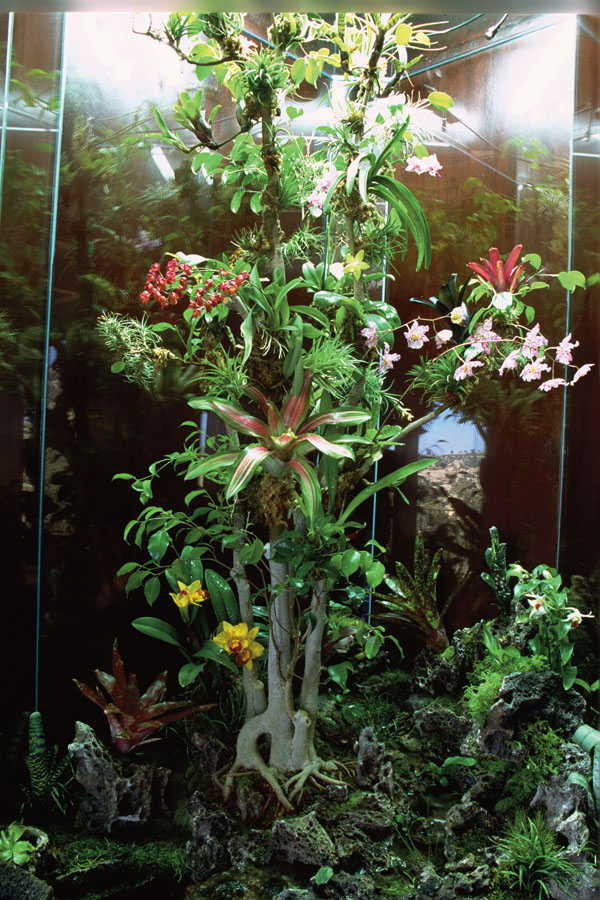
REX LEE SEARCEY
Some of the technology in this tropical rain-forest vivarium is visible. The high-pressure diaphragm pump is in the bottom-left cabinet. The copper line and stainless-steel misters can be seen intruding through the tank’s glass top.
Quality high-pressure misting systems typically use pumps that operate in the 250- to 800-psi range, but some pumps operate at 2,000 psi or more. The larger your system is (e.g., a multiple-tank system or an entire herp room), the higher the water pressure should be for efficient functioning. Tubing for these systems should be rated for high-pressure use, such as reinforced nylon or PVC, and affixed with threaded connectors.
Heat and ultraviolet light, which come from the light fixtures in a vivarium, compromise the structural integrity of most tubing materials over time. This can be especially serious with high-pressure systems, so tubing should be checked every few months for cracks and leaks. Even if tubes seem OK, I suggest replacing them at least yearly. To avoid these problems, copper tubing is also good for high-pressure systems, and it often improves the appearance. Some of the components, such as the connectors, have to be welded using a high-temperature torch and a quality solder containing silver, but if you can have this done, or learn to do it yourself (not as difficult as you may think), it will give you a strong, permanent and good-looking system.
- Misting nozzles deliver ultrafine water droplets into the vivarium. Most commercial systems use plastic misting nozzles, but some plastic nozzles can be replaced with metal ones. Quality misting nozzles of stainless steel, brass and/or nickel can provide a finer mist, a more uniformly accurate delivery of the desired gallons-per-minute rate, and more reliable long-term service than most plastic nozzles.
- The timer turns the misting system on and off. You need the kind typically used for horticultural misting purposes. These allow you to turn on the system numerous times each day for specific, short durations. Ideally, the timer should be capable of durations less than one minute. You must try to set the timer to come on often enough to keep humidity at the desired level. This usually requires some initial experimentation and then ongoing attention as conditions change. In a more sophisticated system, a humidistat automatically keeps humidity at the correct level. Whether you use a timer or a humidistat, include a hygrometer in the vivarium to display humidity. Handy, inexpensive combination thermometer-hygrometers are available.
- All tubing must be rated safe for drinking water use. Low-pressure misting systems use plastic tubing, and high-pressure systems require reinforced-nylon, PVC or copper tubing. Various connectors of the same material as the tubing are necessary. Straight-line connectors (couplers), tee connectors (three-way) and L-shaped (90 degree) connectors are the most common.
- The pump pulls water from the storage container and sends it to the mist nozzles. Most people prefer one that operates quietly. Quality submersible (used in the storage container) or external, in-line pumps can be used, but the most common, efficient type is an external diaphragm pump.
- The water-storage container holds the water used by the misting system. Any container that can be fully enclosed may be used as long as it is rated as safe for food or drinking water use. A typical container is a 5-gallon food-storage container with a lid and snug openings created for the water lines and tubing. In the simplest, most economical system, you manually keep this container filled with distilled or purified water. In systems connected to a water source, this container includes an automatic shut-off device that regulates the water level. The most common shut-off device is a simple ball-and-cock type like those used for toilets and ponds, but smaller, more sophisticated types are available.
- Misting systems connected to the household water supply need a good water-filtration system, which might include a basic carbon filter, a reverse-osmosis filter and/or a deionization filter. An in-line particulate filter (1) removes any large particles before the water gets to the other filter units.
Low-pressure systems are less efficient, and they tend to produce more of a coarse spray, or rain, effect. The materials used in these systems are not a significant concern. Plastic, nylon or PVC tubing is OK, and compression or barb connectors are adequate. You simply push the tubing into these.
Only when a rain chamber is the goal would I recommend a low-pressure system over a high-pressure system. Rain chambers are temporary tanks set up for certain frogs and other herps. They simulate a drenching rain to stimulate breeding behavior or to assist in shedding.
(3)Mist Droplet Size for Reptile Misting Systems
The size of the droplets produced by the system’s misting nozzles is important. It indicates the quality of the mist. Droplets are measured in microns, which is one-millionth of a meter or about 0.00003937 inches. In general, droplet sizes of around 5 microns create a fine fog, around 20 microns create a heavy fog, around 100 microns create a fine spray, around 240 microns create a medium spray, around 400 microns create a heavy or coarse spray, and around 1,000 microns create a fine rain or drizzle. Rain droplets measure more than 1,000 microns. If the droplet size isn’t listed in the information on a system you are considering, ask for it.
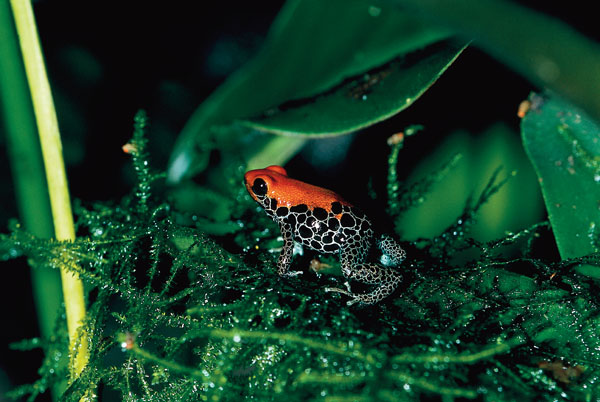
REX LEE SEARCEY
Just by eliminating the need to mist with a spray bottle, any misting system helps with vivarium automation, but some systems are more automatic than others.
It is best to select a droplet size that allows you to get the effect you want with the shortest possible misting duration. To create high humidity while adding hardly any extra water to the vivarium, you want to have a system that produces a fog or fine spray, so you usually want a droplet size less than 100 microns. A fog with droplet sizes in the 20-micron range hangs in the air for about 100 times longer than a heavy spray with droplets in the 400-micron range. A fine fog with droplets in the 5-micron range may still be lingering in the air of a tall vivarium a half-hour after the system has shut off. To create high humidity and a light coat of moisture on leaves and other smooth surfaces (which provides drinking water for some herps and moisture for certain kinds of high-canopy tillandsias and orchids), a mist with droplet sizes in the 100- to 240-micron range is good. For a heavier coating of moisture for certain herps and moisture-loving tillandsias, bromeliads and orchids (which like to get wet but dry out between mistings), a coarse spray with droplets in the 400- to 600-micron range is good. However, care must be exercised here. The time between mistings must be long enough to allow the vivarium to dry well between mistings.
The type of misting nozzle also plays a role in the type of mist produced. I recommend quality nozzles of stainless steel, brass and/or nickel for a high-pressure system. High-pressure pumps combined with metal, low-volume misting nozzles tend to produce nice fogs or fine mists. Low-pressure systems and high-volume nozzles tend to produce heavy sprays and use more water.
(4)Volume Output for Reptile Misting Systems
The output of misting nozzles is measured either in gallons per hour or gallons per minute. Gph is often used for high-output nozzles intended primarily for irrigation use. Gpm is more useful for low-output nozzles intended primarily for humidity-creating purposes, so the quality nozzles you seek for a vivarium misting system will probably be rated using gpm. Nozzles should ideally be designed to deliver only a fraction of a gallon per minute when operating under high pressure.
(5)Water Quality for Reptile Misting Systems
Most municipal (tap) water contains various minerals and chemicals that can cause problems. It could jeopardize the health of vivarium herps and plants, clog misting-system components (especially nozzles), and deposit minerals that create an ugly, hazy film on tank glass and fixtures. You want to eliminate as much of the chemical and mineral pollutants from the water as possible, and there are two ways to get purified water.
One way is to purchase distilled or purified water, and use it as the source for your self-contained misting system. If you do this, then you will not need any water filtration with your misting system. However, you will need to make sure your supply container always has enough water in it for your misting system to operate.
Another way is to incorporate a water-filtration system into your misting system, and this route is mandatory if you connect your misting system to a faucet, hose or other municipal water source. A basic carbon filter is the minimum requirement. It reduces the amount of some of the most harmful compounds. A reverse-osmosis filter removes most of the minerals from the water. A deionization filter removes the chemicals the other filters missed. For the vivaria my company creates, we always use a high-quality filtration system containing all three components. To be really safe, add an in-line particulate filter to remove any large particles before the water gets to the other filter units.
(6)Drainage for Reptile Misting Systems
Closely associated with the misting system is the drainage system. Any water that goes into the vivarium must escape somehow. It is important that the vivarium substrate does not become saturated with excess water, and a good drainage system is one way to ensure substrate saturation is controlled. The best drainage systems incorporate bulkheads in the vivarium bottom connected to a drainage pipe. Usually this pipe leads to a wastewater catchment, and this container must be emptied on a regular basis.
(7)Degree of Automation for Reptile Misting Systems
Just by eliminating the need to mist with a spray bottle, any misting system helps with vivarium automation, but some systems are more automatic than others. If you connect your system directly to the household water supply, then you eliminate some tasks, such as checking the water-supply container and refilling it. Include a humidistat, and it automatically runs your system to maintain the humidity you set. A really good programmable humidistat even adjusts the humidity levels from day to night and season to season. You can also connect the vivarium drainage pipe directly to the household plumbing system just like you would for a sink or toilet, so the vivarium wastewater goes directly into the sewer with no need for anyone to empty anything.
(8)Humidity and Air Circulation Balance for Reptile Misting Systems
Simply reaching the correct humidity level is only half of the job. The other half involves maintaining that humidity while achieving proper fresh-air circulation. Vivarium humidity is a difficult issue for most vivarists primarily because increasing humidity usually involves limiting exposure to the outside air to keep moisture from escaping. But restricting air exchange between the vivarium and the outside disrupts the gaseous composition of the air. Among other changes, the percentage of carbon dioxide can increase to a dangerous level, and percentages of airborne matter, such as dust, fungal spores, bacteria and viruses, can reach unnaturally high levels. Poor air quality inside the vivarium is the result. A quality, efficient misting system can monitor the vivarium humidity and turn on numerous times each day for specific, short durations, so it can keep the humidity level up even with more fresh-air circulation being allowed into the vivarium.
Another way to help maintain humidity and air quality in the vivarium is to use as many live plants as possible. As part of their natural metabolic process, plants remove carbon dioxide and other toxic gases from the air while adding oxygen and humidity. How much toxic gas is removed and how much oxygen and humidity is added varies depending on the species of plant, but most tropical plants, especially those with large, smooth leaves, are very efficient.
Now that you are familiar with these eight fundamentals, you’re ready to hunt for the misting system or parts right for your vivarium. Herpkeeping and horticultural magazines, the Internet and perhaps some reptile stores are good sources to begin your search for a commercial misting system. So do yourself and your herps a favor. Buy or make the best misting system you can afford, and combine it with a good drainage system, ample fresh-air circulation and plenty of beautiful, live plants.
Rex Lee Searcey, through his business, Secret Environments, designs interior and exterior environments with vivaria a specialty. He has bred and studied many anurans, Phelsuma geckos and other lizards. He writes about environmental issues, landscaping, architecture, animals and plants.

